Text
Jane Kim’s March 5, 2024 San Francisco Voter Guide
It’s hard to believe that I drafted my first voter guide in November 2004. Twenty years and countless endorsements later, here we go again! I am only providing additional insight for contested races. If you’re looking for another great voter guide, check out my fave SF League of Pissed Off Voters. I also appreciated the non-partisan analysis provided by San Francisco Public Press.
US Senate: Barbara Lee
From becoming the first black cheerleader in her high school after fighting to desegregate her squad to casting the sole vote in Congress against authorizing the war in Afghanistan in 2001 (history has validated her), Barbara Lee has been fearless and principled. A Nobel Peace Prize nominee, Lee is the only US Senate candidate who has called for an immediate ceasefire in Gaza. As the first state to send two women to the US Senate, I would be disappointed to forward two men. We have two incredibly smart and courageous women candidates running– Congresswomen Barbara Lee and Katie Porter. This March, I’m voting Barbie for US Senate!
US Congress: Nancy Pelosi
State Assembly: Matt Haney, AD 17 and David Lee, AD 19
David has been an active voice and organizer in San Francisco’s Chinese American community since he started the Chinese American Voter Education Project 20 years ago registering thousands of API voters. David is an earnest and sincere neighborhood advocate. While he may not be a nerdy wonk, I know he will fight for tenants, small businesses, and neighborhood safety issues. He promises to be a champion to raise the statewide minimum wage and as a community college educator, fight to expand tuition-free community college tuition statewide.
Judges: Michael Begert and Patrick Thompson
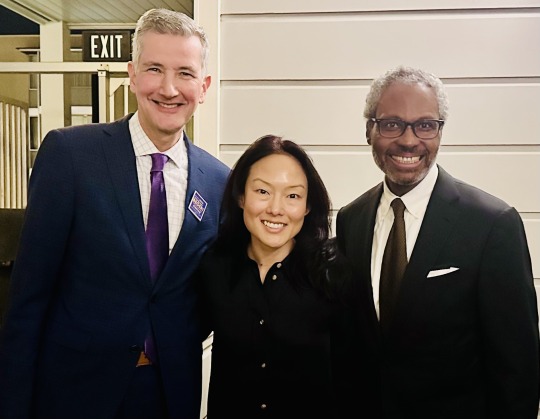
Endorsed by all 48 SF Superior Court judges, San Francisco Chronicle, San Francisco Democratic Party and the League of Pissed Off Voters (an unusual alliance indeed), this race has become a blatant political stunt. Unable to blame the District Attorney for all of San Francisco's woes, the right has shifted their attack to appointed judges vetted by an extensive and rigorous process led by the state. Appointed by Governor Arnold Schwarzenegger and Governor Gavin Newsom respectively, they are hardly radicals but demonstrably qualified.
San Francisco Democratic County Central Committee: Labor and Working Families Slate and ME!
This super down ballot race used to attract an endless list of candidates and ZERO dollars. This year, a few people are pouring $1.1M to defeat our slate which includes educators, a nurse, plumber, elevator mechanic, healthcare worker, youth activists, union organizers, and even an attorney/drag queen.
My amazing slate mates are busting their quads, volunteering countless hours to walk hilly precincts, canvass farmers markets to win VOLUNTEER positions on the San Francisco Democratic Party. Most of the year, committee members register voters and participate in phone banking efforts to flip red seats blue, not only in California but across the nation. We just want a corporate-free Democratic Party in our city. And we love San Francisco.
Don’t worry, you’ll always hear from people who have millions to spend to influence elections- do they need the Democratic Party too?
Here is our slate in the order we are listed on the ballot!
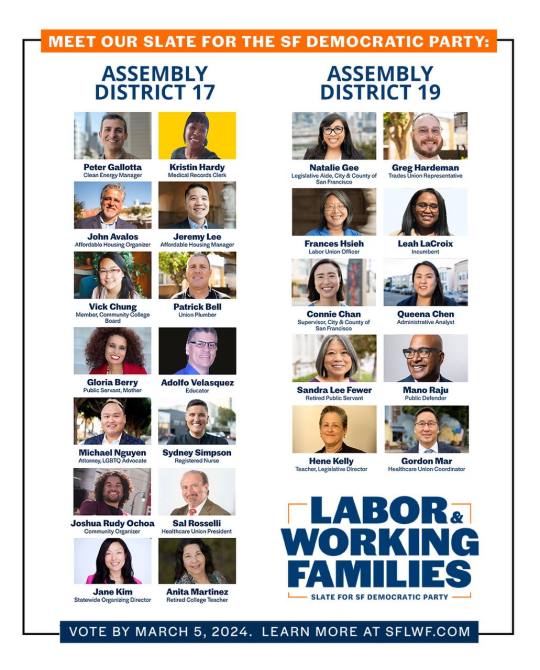
Proposition A: $300M Affordable Housing Bond: YES, YES, YES
Endorsed by the Mayor, the entire Board of Supervisors and literally everyone else who endorses anything (minus the SF Republican Party), we need this revenue source to continue to build and preserve affordable and middle income housing in San Francisco.
Proposition B: Police Officer Staffing Levels Conditioned on Future Tax Funding: No
This is not a terrible measure– it raises minimum police staffing levels if the city raises new revenue. However, I believe the Mayor and Board of Supervisors should set police staffing numbers, not the voters.
Proposition C: Real Estate Transfer Tax Break for Developers: No
Prop C provides tax breaks for downtown office developers who sell their building after converting it to market rate housing. I would have supported this largely symbolic gesture– symbolic because very few office buildings can convert to housing due to high costs and structural limitations. HOWEVER, this measure dangerously authorizes the Board of Supervisors to reverse prior victories in real estate transfer taxes that fund essential initiatives like FREE CITY COLLEGE and street tree maintenance (yes the very measure I authored in 2016) and affordable housing.
Side note–prior to 2016, San Francisco homeowners briefly had to shoulder the burden of street tree maintenance, which was both substantial and perplexing. This measure jeopardizes this revenue.
Proposition E: Blank Check on Police Surveillance and Car Chases: No, No, No
This one is all over the place and a perfect example of why I do not believe in legislating via the ballot box. SF Chronicle calls it “a fistful of dubious public safety ideas at the wall in hope one sticks.”
Proposition E is a package of policy changes that would allow the San Francisco Police Department to engage in more high-speed chases, install security cameras in public spaces (currently approved by a civilian oversight body) and test surveillance technology (ie. drones and facial recognition) on the public without oversight. It would also allow police to file fewer reports on use of force against members of the public.
There is one good idea— we should reduce how much time police officers spend on administrative paperwork so cops are on the streets instead of behind desks but there is no teeth to make this happen. And I am open to cops utilizing technological advances in their work- should cops have drones to follow active pursuits? Maybe, but I don’t want voters to write this blank check. This job belongs to the people we elect– the Mayor and Board of Supervisors who can study recommendations made by our SFPD Chief and the civilian oversight commission, evaluate studies and weigh public comment.
But there are some terrible ideas such as expanding police chases on congested San Francisco streets. I witnessed the devastating consequences when my best friend was struck by a fleeing vehicle two years ago. The perpetrator got away (but eventually arrested months later) but my friend continues to endure life-altering injuries. While no blame falls on the SFPD officer, the pursuit inflicted irreversible harm without achieving its intended outcome.
It’s opposed by the ACLU, Electronic Frontier Foundation, San Francisco Bar Association and League of Women Voters.
Proposition F: Drug Screenings for Welfare Recipients: Just say NO
During the “War on Drugs” of the 80’s and 90’s, we targeted poor people for drug usage and guess what? The policy failed to decrease usage and only pushed our most vulnerable neighbors away from assistance. Reverting to this Republican strategy, endorsed by the Trump administration and poorly implemented in red states like Alabama and Mississippi, is mind boggling. The estimated annual cost of this program ranges from $500,000 to $1.4 million, partially offset by discontinuing payments to our poorest residents who refuse testing.
Meanwhile, San Francisco has a waiting list of people who actually want treatment.
Let’s look at states who have enacted this– very few applicants get tested and even less come back positive. The most expensive drug testing program was Missouri. Missouri spent a whopping $336,297 in public funds to test 108 individuals out of 32,774 applicants. 11 came back positive.
Elected leaders want to appear like they are doing something about the devastating fentanyl crisis (precipitated by billionaire pharmaceutical conglomerates like Purdue/Sacker family), but THIS IS NOT IT. Even the San Francisco Chronicle, hardly a bastion for progressive politics, says No on F.
Prop G: 8th Grade Algebra: YES
I fully support offering Algebra in the 8th grade. Frankly I support offering Algebra at any grade students wish to enroll. But this is yet again another symbolic resolution (do you see a pattern?) which is now moot as the Board of Education voted this month to re-offer 8th grade algebra.
If you made it this far, thank you for reading and more importantly, thank you for voting. Agree or disagree, I appreciate you including my perspective in your decision making.
Most importantly, if you are voting by mail, please vote by March 4. Thousands of ballots go uncounted because people put them in the mailbox on March 5 without checking the final pick up time– these ballots are postmarked March 6 and are therefore invalid.
0 notes
Text
Pursuing the Ritual of Discomfort

Only thing I’m scared of is staying the same. Denizen Kane aka Dennis Kim
Four months into the pandemic, I finally accepted that the gym was not opening again soon and even if they did re-open, I was not ready to heave and gulp air in a humid, unventilated indoor space with other sweating beings.
In good news, I was doing yoga three times a week without worrying about running late from a meeting and borrowed weights (remember when you couldn’t buy weights anywhere??) from my friend @photomatt who graciously loaned me his lighter weights.
But I wasn’t getting my heart rate up.
Since I was young, the activity I dreaded most was running. Running has always been hard for me— the difficult breathing, heart pumping uncomfortably, and undefined goals. There was no ball or punching bag to fixate on. Running in pre pandemic days was limited to catching buses and trains, often in heels. And I swore my ancestors did not run or my lung capacity was smaller than average.
In the midst of the pandemic, a friend I admired wrote a beautiful longform article about his 30 year journey as a runner. In my many years of knowing him, I did not know that he was an accomplished amateur runner with corporate sponsors.
So I researched how to start running as an adult. The most helpful instruction I read was simple— run for 20 minutes without tracking speed.
So I laced up and ventured to the Embarcadero to join the ranks of the “active”people I had never identified with.
At first I was running 13-14 minute miles. A few friends teased me that they could walk alongside me. But I was out and moving.
I committed to running twice a week— no matter how I was feeling. I sought beautiful places to run to distract me. I discovered Mount Sutro behind UCSF, Rodeo Beach by Marin Headlands and the coastline of California. I created energetic playlists I could only listen to while running.
I got faster. And soon I was running two miles- unimaginable to someone who couldn’t run a 1/4 mile continuously.
But it never got easy. I kept waiting for this elusive runner’s high or the day I would become the friend who gushed about how much they love running. Worse, I would get better and then experience my speed and distance decline precipitously again. I would see friends on social media, who also announced they had embarked on the same brilliant pandemic endeavor, planning their half marathons after two months of running.
I was struggling to get to 3 miles. And I still hated the act of running.
I grumbled to my yoga teacher, a lifelong runner who writes about exercise and longevity, and he described it as the ritual of discomfort.
These three words transformed my approach. I don’t have to enjoy running. And there is a value in the practice of doing something uncomfortable— pushing past the imagined limits of my mind and body.
So I kept running. I ran in the snow (with tractions on my sneakers), summer rainstorms, up mountainous hiking trails and under showering cherry blossoms.
I pack my sneakers when traveling— and have discovered it is a delightful way to enjoy a majestic landscape or observe how people move in a city. I logged miles in Seoul, Tokyo, Paris, Vancouver, Mexico City (yes with its altitude of 7350 ft!), Phoenix, Grand Canyon, Honolulu, Jackson and New York City. I saw 9p workout classes lit by the summer sun along the Seine River, a 7a picnic date on the Han River, and a foggy, muddy, tree tangled forest in Honolulu.
And it’s free.
I recently hit my three year anniversary and while I am not where I hope to be, I can coax my mind to run 6-8 miles weekly at a pace ranging from 8.5-10.5 minute miles- spending more of my time on the less hurried end.
I am no longer always the slowest runner but I am still sometimes the slowest runner.
As is often said in Buddhism, our time on earth is made up of the 10,000 joys and 10,000 sorrows. Life can be unforgiving in teaching you these lessons. Yet both the blissful joys and unimaginable grief have shaped my spirit and soul in beautiful ways.
And I am stronger. I can feel how much lighter my legs and more expansive my lungs are. My last bloodwork was off the charts. I devote a small part of my week to exploring this container, my physical body, something I am always with but am not always present with. And I am more in awe of this gift which holds and carries my spirit.
The ritual of discomfort has become my practice.
I acknowledge three inspirations for this post— Nick Thompson, Jai Sugrim and finally Matt Mullenweg, who took me on my first adult run in Seoul and inspires me to write

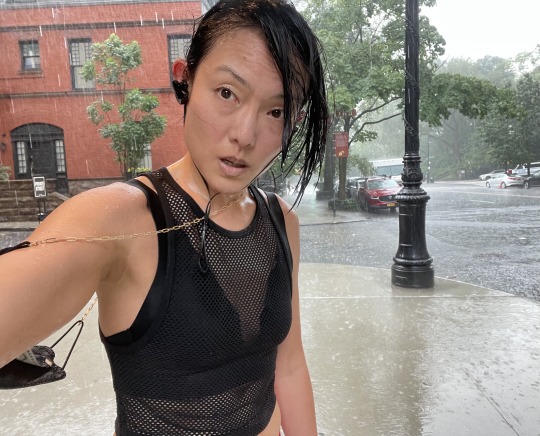

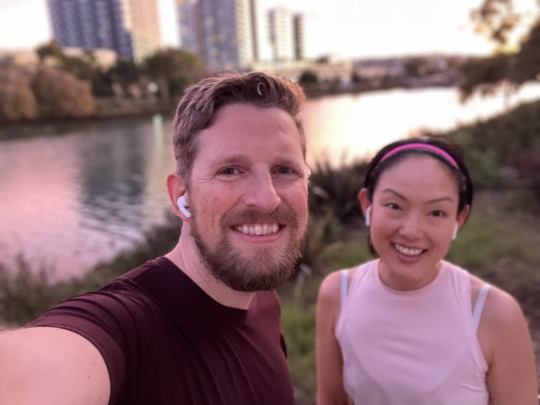
2 notes
·
View notes
Text
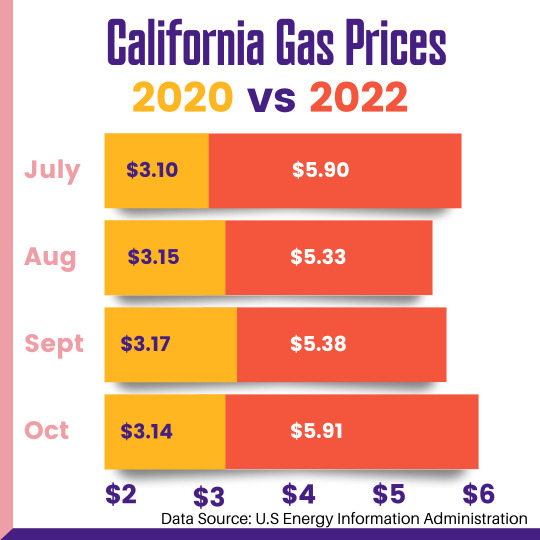
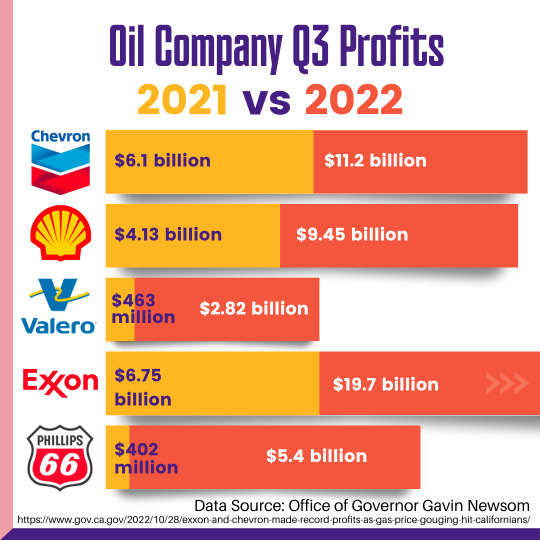
California, let's #StopBigOil
In 2020, while working families across California suffered economic turmoil amidst a global pandemic, we also saw peak gas prices reaching as high as nearly $6. While oil companies claimed that the cause of this increase was state taxes or the war in Ukraine,
the reality is that these prices were the result of price gouging and corporate greed.
In 2021, California taxes on oil had not increase and the United States was EXPORTING more petroleum than it was importing. Crude oil costs were actually dropping as gas prices remained high.
Long story short, oil companies took advantage of Californians in an already trying time for the sake of their own financial benefit. As a result, oil companies saw RECORD profits and face no penalties.
In effort to stop this from happening again, California Senator Nancy Skinner introduced Assembly Bill 2, an oil price gouging penalty bill. This bill is what working families across California need & deserve, but it won’t pass without support from our CA Legislators.
Sign our petition to let your legislator know that you’re watching & you expect their support for SB2 to #StopBigOil : https://actionnetwork.org/petitions/support-an-oil-price-gouging-penalty
22 notes
·
View notes
Text
#YearofRabbit California Policy Dream List for Working Families
One year ago, I joined the Working Families Party to expand its organizing to the largest state in the nation- California. Tasked with the goal of activating an electorate which overwhelmingly voted for Bernie Sanders for President in 2020 and identifying and winning candidates who actually represent the working families of California, we got to work.
California Working Families Party endorsed 59 candidates in the 2022 election cycle and hosted more than 300 events– doorknocking, phonebanks, text banks and virtual townhalls to support them. In a promising story of California’s future, 56 of our WFP endorsed candidates identify as people of color and the majority are women.
Read more...
In our inaugural year, eight California Working Families Squad Legislators, committed to fight for tenant protections, climate justice and fair wages won, expanding our corporate free squad in Sacramento from two to eight. While Democrats dominate California, too many legislators have sided with big money, choosing Big Oil or Big Pharma over the health of our communities. In fact, Big Oil (more on this later), is the biggest political spender in California funding 78 out 120 state legislators.
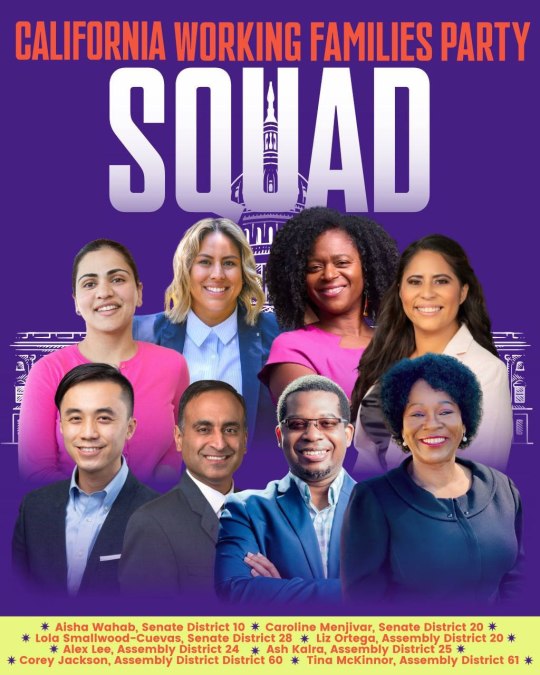
Six Working Families mayoral candidates won, Karen Bass for Los Angeles Mayor, Paloma Aguirre for Imperial Beach Mayor, Ulises Cabrera for Moreno Valley Mayor, Eduardo Martinez for Richmond City Mayor, and Rex Richardson for Long Beach City Mayor and Sheng Thao for Oakland Mayor. (Check out our GOTV Rally for Karen Bass for Los Angeles Mayor with Senator Bernie Sanders co-hosted by the California Working Families Party!)
California WFP also backed progressive champions for Board of Supervisors, City Council and Board of Education races to impact local communities and build a pipeline of candidates for higher office. This is a promising bench in California where three out of four eligible voters under 30 is a person of color.
California Policy Dream List 2023-2024
“Liberals want to do nice things. And progressives understand that you have to take on powerful special interests to make it happen.” U.S. Senator Bernie Sanders
Winning office is not our goal. Winning a Working Families policy agenda which lifts all working Californians is our goal. As we enter #YearofRabbit, a zodiac animal known for steadily moving towards their goal, here’s my California Policy Dream List- winnable, fundable + impactful.
1. Grow our California Squad to 20 by 2026, ensuring corporate free, Working Families champions make up ⅙ of our California legislature.
While this may seem small, a group of 20 courageous and energetic leaders can move an agenda while activating and organizing our base. They can shine a light on the corporate backed legislative agenda and introduce a peoples first policy agenda to positively impact the lives of everyday Californians.
2. Medicare for *ALL* Kids
At least 4M children across our nation lack access to health care today. While our ultimate goal is Medicare for ALL, starting with children is a good start. Imagine a world where all newborn babies, rich and poor, go home with a name, birth certificate and health insurance.
Providing children with health care is relatively cheap. The average child's medical needs, including vaccines and checkups, are routine, low-cost and preventative. Children make up a quarter of the U.S. population, but generate less than 12% of total health care spending and children would improve Medicare’s financial profile by lowering average costs.
Guaranteeing coverage for all kids would benefit all families– low-income and working-class families would be enrolled automatically without paperwork or expensive outreach and education programs in multiple languages. Medicaid is currently the third-largest anti-poverty program, responsible for raising 2 to 3M people out of poverty— reducing medical debt and bankruptcies. Medicare for Kids is also a subsidy to middle-class families who currently spend money on co-pays for visits and medication and sometimes significant or unaffordable deductibles. In fact, private health care does not guarantee access to care when out of pocket costs effectively eliminate access. In addition, all children will get continuous, uninterrupted care with a familiar doctor instead of getting yanked in and out of coverage due to parent’s change of employment, job loss or change in income.
Finally, we will raise a generation of voters who will not view Medicare as a socialist fantasy or nightmare but a generation which will have normalized a single payer healthcare system.
Oh, it’s also popular. According to a 2019 poll by Data for Progress poll, 80% of registered Democrats support Medicare for Kids.
3. Take on Big Oil
Big Oil is the biggest political spender in California, yet most voters in our blue state are unaware of the power the industry holds in Sacramento. 78 out of 120 California legislators, Republicans and Democrats, accepted oil money. California is the 7th largest oil producing state and continues to approve fracking permits as wildfires and smoke choke our communities. Worse, over 7M Californians live within one mile of an active oil well, putting them at greater risk of asthma, cancer and early births.
After a decade of organizing, this past September, the California legislature finally passed a bill (SB 1137) to ban NEW oil drilling within 3200 feet of homes, schools and playgrounds and within days, Big Oil announced they were gathering signatures to repeal this bill. Other billionaire corporations also unhappy with policies to support workers, gathered signatures to overturn AB 257, a first in nation bill to establish sectoral bargaining for fast food workers. Both have qualified for the November 2024 ballot.
We can defeat those pro-corporate ballot initiatives and go on offense. Finally tired of $8/gallon headlines, Democrats announced they would introduce a bill to penalize oil price gouging. Financial reports revealed that the five companies producing 97% of all of California’s oil and gas, quadrupled their profits in the first nine months of 2022. California had the highest gouge gap in the nation–billions of dollars went from the pocketbooks of hardworking Californians only to enrich billionaire CEO’s and shareholders. It’s time to fight back.
4. Raise the Minimum Wage: One Job Should Be Enough
The Fight for 15 had real, measurable impacts on workers' pay. This January, California’s minimum wage rose to $15.50 and an estimated 5.6M Californians will earn at least $20B more, an amount larger than all of California’s major public assistance programs combined.
Yet, we have still not kept up with the living wage needed across California. There is not a single county where a minimum wage worker can afford to rent a two bedroom apartment for themselves and their family. New York and Rhode Island introduced $21/hour and Idaho and Massachusetts introduced $20/hour. California can and should continue to lead this fight for minimum wage workers, the vast majority of whom are women.
And we should raise the minimum wage for all workers including incarcerated inmates who currently make pennies on the hour for jobs which include fighting California’s wildfires.
5. Tax Extreme Wealth
During the pandemic, billionaires grew $2 trillion while millions of Americans filed for unemployment or risked their lives as essential workers. 44% of that wealth grew in California alone. California has the most billionaires and the highest poverty rate in the nation. This is a policy failure.
In month, California, Connecticut, Hawaii, Illinois, Maryland, New York and Washington all introduced a Wealth Tax on the extreme rich. The California Wealth Tax is modeled on US Senator Elizabeth Warren's, specifically targeting extreme wealth over $50M and $1B. If passed, it would generate $22.3B/year for California. California has one of the most progressive income tax rates in the country, effectively taxing for example, a rich doctor who primarily earns their money through income. However, the wealthiest Californians report very little income– avoiding taxes on the vast majority of their wealth. We should remedy this inequity and tax all wealth.
5. Free Bus Pilots
It is exciting to see cities such as Washington DC and Boston pilot fare free bus programs while New York legislators consider similar proposals. Free bus programs make public transportation more accessible, encourage people to ride instead of drive, reduce congestion and pollution, and disproportionately benefit low-income individuals and families (again without the hassle of paperwork, expensive outreach programs and bureaucratic income verification). Imagine cities which provide free buses for residents and visitors to ride to work, school and play!
California is changing
Over the next decade, we are going to see the continued growth and power of California voters currently under 45. And they are disproportionately people of color and immigrants.
California is ready to lead a working families agenda for the nation. There is a growing base of multiracial, cross-class voters that want to tackle widening wealth inequality, the untenable affordability crisis, and wildfires turning our communities to ash. Our challenge is to organize that base of voters into a movement that can make this wish list a reality and deliver for the people.

5 notes
·
View notes